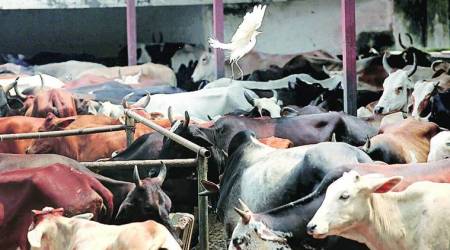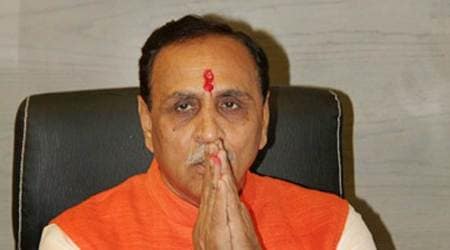 Stray cattle at Saketu village in Lakhimpur Kheri. Vishal Srivastav
Stray cattle at Saketu village in Lakhimpur Kheri. Vishal Srivastav
AMID HEAVY rain, the rising level of the Sharda river is a looming threat for Saketu village, surrounded by lush green fields of sugarcane, paddy and plantain, in UP’s Lakhimpur Kheri district. But what’s really keeping its residents awake at night is this: “Chhutta gau dhan”, or stray cattle, that they say has already destroyed crops worth thousands of rupees. They have tried every trick in the book to tackle this “curse”: standing guard at their fields in shifts through nights; blocking others from taking cattle through Saketu; even rounding up stray cattle and tying them up at the local school. But nothing’s working, they say, especially with police launching a crackdown on the transport and trade of cattle in a state where a cow-slaughter ban has been in place for 62 years.
“Here, men and women have to take turns to guard the fields. There used to be stray animals earlier, too, but in small numbers. Over the last few months, the number has reached hundreds. There are no claimants for these animals. Sometimes, villagers from neighbouring areas leave their cattle here at night. What can they do, there are no takers for non-milching cattle,” says Mishri Lal, adding that his sugarcane crop on one bigha of land, “worth at least Rs 30,000”, was destroyed last month.
“Earlier, there used to be takers in the market for non-milching cows but now they say their vehicles are being stopped. Often, police do not allow us to go to the market with our cows,” says Harbans, a father of three, who lost a big chunk of his twin crop of corn and pulses over a month ago. Recalling the day he lost his crop, Harbans says, “I could not to protect my fields that night because I was ill and my brother was away. I had grown corn and pulses on about 10 bighas of land taken on ‘adhiya’ (where he is entitled to half the produce). Early the next morning, I was informed that over 90 per cent of my crop has been destroyed by stray cattle… Woh toh kaal ban-ke aayi thi, ab yeh gau dhan nahi rah gaya (They came as a curse that day. The cow is no longer wealth for us).”
Harbans says that while the pulses would have given him at least Rs 5,000 per quintal, the corn was to be used as fodder for the cattle he owns — two bulls, two cows and a calf. “My cow has been giving just one litre of milk over the last few months. I cannot feed her and no one is ready to buy her, even for Rs 200. I have not left her but on most days, I have to choose between feeding these cattle and my children,” he says.
Residents say the situation finally led to a confrontation with neighbouring villagers. “Over a month ago, we stopped our neighbours in Dingra village from passing through to reach the forest nearby and graze their cattle. These animals would come to our village to graze instead,” says Vikral Verma, adding that his two-acre sugarcane crop was destroyed two weeks ago.
”After we stopped them, they stopped us from passing through their village to reach the city. The issue was resolved following the intervention of police and local officials,” says Verma.
Three days ago, Saketu’s residents rounded up around 100 stray cattle and tied them inside the local government primary school, forcing the teachers to declare a day’s holiday for the 251 students. Again, the local authorities had to step in. The school’s premises were cleared the next day although the backyard is still home to around 20 cows tied to the old trunk of an uprooted tree.
”The parents of the students did not mind the one-day closure. We did it to draw the attention of the administration towards our problem. We felt that this might bring about some solution,” says a Saketu resident.
According to government officials, the Uttar Pradesh Prevention of Cow Slaughter Act has been in place since 1955 but the norms have been tightened after a major reshuffle in administration by the Yogi Adityanath government in April, with Sulkhan Singh taking charge as DGP. Officials said that the government has since issued orders to police officers in all districts to book those involved in cow slaughter, and smuggling of cows and their progeny, under the National Security Act (NSA) and Gangsters Act.
Says Akash Deep, District Magistrate, Lakhimpur Kheri, “There cannot be any immediate solution to this problem. I have been in touch with some non-government organisations to construct cow shelters in the village. We have offered to give them land if required. But these things will take some time.” Two days ago, after the cattle were tied up inside the school, Chief Minister Adityanath asked senior officials to establish cow-shelters, with a capacity of 1,000 each, in seven districts of Bundelkhand and in 16 municipal corporations. But the residents of Saketu are not convinced. They fear these may not be enough.

